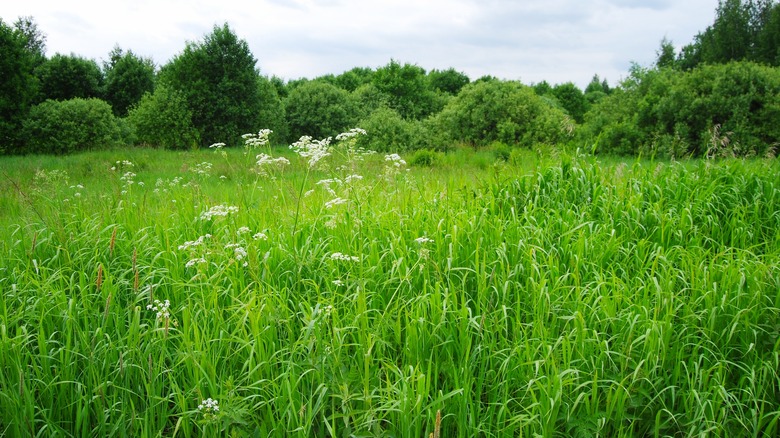With increased awareness of climate and ecological responsibility, the “lazy lawn” has grown in popularity as of late. Not to mention, doing a lot less to take care of your yard just sounds more appealing. How do you do it? Simply! Care less about your lawn. Mow it less frequently, water it seldomly, and fertilize it only once or twice a season. Not only will this laissez-faire attitude help your budget by lowering your water and gas bills, but it will also benefit the natural state of vegetation and wildlife in your yard by attracting beneficial pollinators and incorporating natural fertilization from grass clippings.
Allowing your lawn to grow naturally for two to three weeks creates natural shelter for important pollinators like bees and butterflies, which are beneficial not only to the environment as a whole, but also to the flowers or veggies you grow in your garden. You can bet on bigger, brighter blooms and a more bountiful harvest by letting those dandelions or wildflowers pop up across your yard. At the same time, by mowing your lawn less, fewer toxic fumes and pollutants will be produced around your home, improving the air quality and contributing to a more healthy lawn and yard.
Lazy lawn care

Lazy lawn care really is as simple as it sounds. The first step is to mow your lawn less frequently. Allow the grass to grow for several weeks between mowings, especially in the spring. Mowing your lawn less will encourage the grass to develop better roots, contributing to a healthier lawn. Better roots also means the grass will be more drought-tolerant, so you’ll need to water it less, saving you money on your water bill. When you do mow it, raise the blades to a higher setting to keep the grass longer. Longer grass means more shaded soil, which will help the ground from drying out. The shaded lawn will also deter crabgrass, as there won’t be adequate sunlight for it and other pesky weeds to develop.
While you mow the lawn, allow the grass clippings to fall and collect naturally across your yard. The cut grass contains carbon which will break down over time and fertilize the grass without a need for chemicals. Skipping chemicals is better for the overall health of the lawn and the creatures that reside there. Speaking of the lawn and its creatures—worried about ticks? Fear not! A study by the U.S. Department of Agriculture found that longer grass did not attract any more ticks than a lawn with short grass. You and your furry friends will be safe while you enjoy the fruits of your lazy lawn.
Grass alternatives for a lazy lawn
While your lawn is thriving naturally, consider incorporating some grass alternatives to sections of your lawn, particularly where grass might already have trouble growing. Let your lawn run wild! One great grass alternative is moss. It thrives in shady areas and requires minimal care. Compared to grass, moss needs very little water to survive. Two minutes of water from a sprinkler in the morning will be more than enough to suffice. Moss provides a similar aesthetic to short grass, carpeting your yard in a rich evergreen.
Another suitable grass alternative is creeping jenny. It is a low-growing perennial with trailing stems and round, bright green leaves, though it is available in several varieties of varying shades. Creeping jenny prefers partial shade and well-draining soil. Though it does require dutiful watering to be established, it is quite drought-tolerant once its roots have developed. Fortunately, creeping jenny is not prone to many pests, though it can become aggressive if left completely untamed. Simply cut it back as necessary, and it will recover easily.
Finally, spice up your lazy lawn with some aromatic thyme. This creeping herb is drought-tolerant, releases a pleasant fragrance when walked upon, and requires little maintenance. It’s a delightful option for sunny areas, and you can even use it in your culinary adventures. Thyme will naturally thwart weeds and does not need to be mowed or fertilized in order to thrive. It’s a lovely grass alternative!